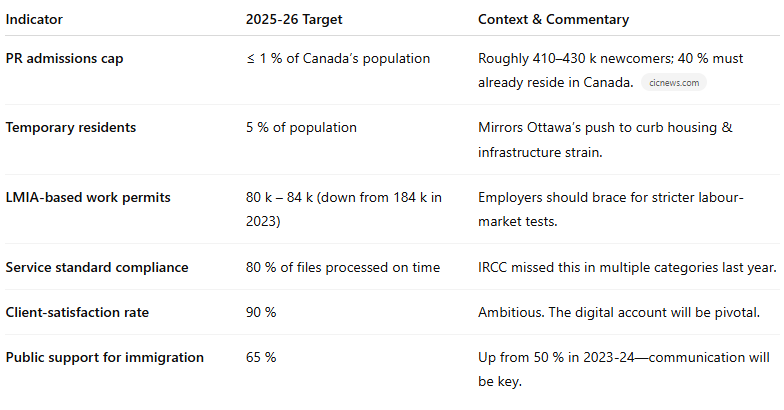Major Changes Announced for 2025-2026


IRCC’s 2025-26 Departmental Plan: What I’m Watching (and Why It Matters to You)
Why this plan is worth your time
Every spring I read IRCC’s Departmental Plan cover-to-cover. It is the only public document that ties the department’s money, timelines and performance targets together, giving us a clear view of where immigration policy is actually headed. Below is my plain-language digest of the 2025-26 plan, with commentary drawn from my day-to-day work helping newcomers, employers and students.
The Economic Mobility Pathways Pilot (EMPP) goes permanent
IRCC commits to making the EMPP a regular program by the end of 2025, transforming a niche refugee-to-work pathway into a stable tool for employers who need hard-to-find skilled talent. (canada.ca)
My take: If you recruit in healthcare, trades or tech, start mapping out roles that could be filled through the EMPP before your competitors do.
A sector-specific stream for agriculture and fish processing
Working with Employment and Social Development Canada, IRCC will create a dedicated foreign-labour stream complete with its own sector-specific work permit for agriculture and fish-processing employers. (canada.ca)
My take: Review housing and settlement supports now; early compliance will likely earn priority processing once the stream launches.
Study and family work-permit rules tighten
The department plans to:
Cap most study-permit intakes and annually index the cost-of-living funds students must show. (canada.ca)
Re-align Post-Graduation Work Permit (PGWP) eligibility to a list of “job-aligned” fields updated every year. (canada.ca)
Update eligibility for Spousal Open Work Permits (SOWP) tied to both students and foreign workers. (canada.ca)
My take: Choose programs that feed into Canada’s labour-market gaps and do not assume a spouse’s open work-permit will be automatic.
Faster work permits through new trade-mobility clauses
IRCC is negotiating labour-mobility pathways in free-trade talks with ASEAN, Indonesia, Ecuador and CPTPP accession candidates—all of which normally translate into LMIA-exempt, employer-specific permits. (canada.ca)
One digital window for every IRCC client
The long-running Digital Platform Modernization will deliver a single online account offering real-time status and document uploads across all application types. (canada.ca)
My take: Submit early if you can; big tech roll-outs often come with temporary service interruptions.
A renewed push for Francophone immigration outside Quebec
IRCC doubles down on its goal that 8.5 percent of new permanent residents outside Quebec identify as French-speaking by the end of 2025. (canada.ca)
My take: Even intermediate French can become a decisive advantage in Express Entry’s category-based draws or certain Provincial Nominee Programs.
Targets that frame the big picture
What this means for you
Prospective Economic Immigrants – Align your Express Entry profile with category-based draws (health, trades, STEM, French) or the soon-to-be permanent EMPP.
Employers – Plan recruitment around the new agri/fish stream and anticipate tighter LMIA quotas elsewhere.
International Students & Families – Budget for higher proof-of-funds and verify that your program remains PGWP-eligible; spouses should prepare backup work-permit strategies.
Temporary Residents in Canada – Maintain status meticulously; IRCC plans to prioritise in-Canada candidates for PR but will penalise duplicate filings.
Francophone & Bilingual Candidates – Take advantage of community-driven incentives and French-priority selection rounds.
Final thoughts
The 2025-26 plan reflects a balancing act: dialling back the sheer volume of temporary visas while carving out precise, labour-market-driven pathways to permanent residence. The common thread is alignment—with Canada’s labour needs, regional capacity and public sentiment.
If you’re ready to turn these policy signals into a concrete immigration strategy, let’s talk. At Bhani Immigration I translate government plans into successful applications—one client at a time.
—O.J. Bansal, RCIC
